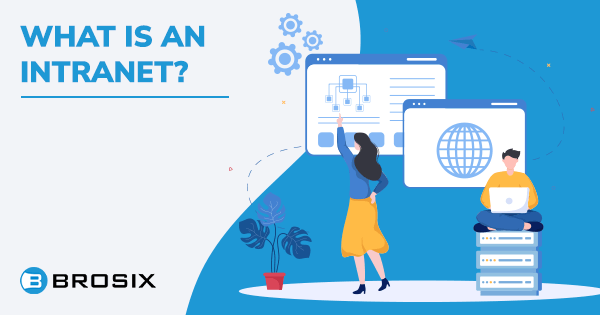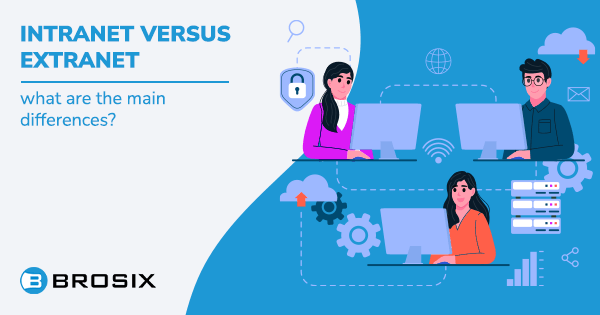In today’s digitized work sphere, many companies use the internet, intranet, and extranet for different purposes.
While all of them assist business and communication, they are inherently different types of networks.
For most of us, the concept of the internet is pretty straightforward, but understanding the unique differences between intranets and extranets can be a little confusing.
An intranet is a private network within the organization that allows employees to communicate, share information, and create content internally. Whereas, an extranet is a private network allowing only authorized access to parts of the internal network from third parties, such as partners, vendors, or customers.
Intranet and extranet software can improve daily operations and increase work productivity once included in a business paradigm.
In this article, we’re going to further explore intranets and extranets and uncover the main benefits and critical differences between them.
What Is an Intranet?
An intranet is a secure and private website that only people from within a company can access.
The prefix “intra” means inside or within, hence companies use an intranet internally to organize and centralize employees, documents, tools, communication, and projects.
The main difference between the internet and an intranet is that an intranet doesn’t allow public access to private servers.
An intranet contains essential company news, data, documents, business tools, processes and strategies.
In the past all internal communication was mainly through paper records. However, an intranet allows companies to streamline business processes in a secure way.
Beyond its main purpose of storing internal information, businesses use an intranet for many other reasons.
Intranets help with structuring operations, better organization and communication, and even generating higher employee engagement.
Especially when working with hybrid and remote teams, an intranet addresses many challenges, connecting team members, information and projects, regardless of physical distance.
That being said, let’s explore how businesses can benefit from it.
Benefits of Using an Intranet
As already mentioned, an intranet can help companies with communication, collaboration and connectivity.
Here are the main intranet usage benefits:
1. Better internal communication
Improving communication processes should be a top priority if you want a productive team.
When employees face blocks in their daily communication with colleagues, it causes frustration, which in turn affects productivity.
By using an intranet, you encourage fluid conversations within your organization.
Specific intranet capabilities, such as instant messenger, notifications, and virtual places, enhance workplace collaboration throughout the whole business.
You can take internal communication even further and distribute departmental information.
Thanks to an intranet and online workspaces, you can create internal groups which only department members have access to.
This way, you can quickly share important documents, papers, articles, and news, ensuring that notifications don’t get lost or left unread in email threads.
2. Centralized and secured information
An intranet can serve as a centralized hub where all business information can be easily found by any employee in a few clicks.
Through an intranet, you can distribute company announcements, share internal documents, and even survey your employees through QA sessions.
This helps boost productivity and efficiency, as employees no longer need to open different tabs or multiple apps to seek information.
By sharing knowledge in a single hub, you set your employees up for success.
When all business information is straightforwardly shared with employees, you ensure they are aligned with the company’s goals.
By centralizing and sharing information through an intranet, you also create a transparent work-life culture.
Employees are up-to-date with news and announcements, and you create a safe space where your employees feel comfortable sharing their ideas.
3. Efficient project management
Probably one of the biggest intranet advantages within your business is that it helps with project management and workflow overview.
An intranet helps keep everyone on track with every stage of a project.
Assign each team member specific tasks and easily keep track of everyone’s progress.
You can even set team objectives and analyze your performance at the end of the project.
Every part of a project can be tracked using an activity stream and logged in a task management application.
4. Boosted team productivity
By sharing information in a transparent way, you contribute to higher employee engagement and enhanced team productivity.
The collaboration facilities provided by intranet software make it simpler and more convenient for employees to complete their daily tasks.
Consequently, more time is spent productively and less time wasted looking for “how” to do tasks.
Moreover, it’s important for employees to feel heard and create positive long-lasting relationships with their colleagues in order to maximize productivity.
Being clear in your communication through the use of an intranet creates a safe space where your employees feel comfortable communicating their struggles and achievements alike.
This ultimately helps you to easily spot bottlenecks and performance issues, and address them in a timely manner.
5. Efficient employee onboarding
Lastly, the use of intranet can also help with the onboarding and training of new hires.
Through a company intranet, new team members can receive all the onboarding information they need to get started on the right track with the company’s values and objectives.
When finished, digital papers can be instantly delivered to Human Resources.
You can also create tasks for new hires to complete as part of their onboarding process, such as reading the company’s internal procedures or researching competitors on the market.
Long gone are the days of in-person onboarding processes. You can now automate them with the help of an intranet.
What Is an Extranet?
An extranet is a private network through which internal members can communicate with external members, while an intranet is software used for internal communication. The prefix “extra” means outside or beyond.
Companies communicate and share information through an extranet with business suppliers, clients, vendors, partners and other authorized parties.
Its primary purpose is to facilitate collaboration, communication, document sharing and data transfer in a secure way.
An extranet software can serve many business-to-business related purposes, such as checking project statuses, sending emails, exchanging large volumes of data, and more.
An extranet is also useful for brainstorming with customers or partners, as it saves time and prevents issues later down the line that might arise with a business’s goods or services.
Benefits of Using an Extranet
Although similar in nature to an intranet, an extranet is used for different purposes, thus bringing other benefits to the table.
Let’s take a closer look at the key advantages of an extranet.
1. Boosted customer satisfaction
The main asset of using an extranet is that it allows your clients access to critical information and knowledge, therefore facilitating smooth collaboration.
Through an extranet, your clients can review projects and order statuses and communicate more efficiently with your sales team.
This kind of network particularly shines in a hybrid working context, where your clients might not always have the same working hours as your team.
With the help of an extranet, you can easily exchange information (such as papers, questions and designs/concepts) with your customers.
At the end of the day, a client who has an overview of processes and projects is a happy client, which is something every business strives for.
2. Efficient and secured document sharing
With the advancement of technology, the frequency of cyber attacks has increased, which poses real dangers to businesses.
While you have better control over these data breaches and cyber attacks internally, when communicating with external parties, things can get rocky.
Emails and other document-sharing tools for external collaboration aren’t always secure enough to prevent security breaches.
The extranet maintains the security of all uploaded documents and information. It only allows access to those with authorization and credentials.
This way, you can rest assured that all documents are securely saved in one location and can be easily found by those with proper authorization.
3. Improved business processes
Another advantage of keeping your documents secured is that it speeds up B2B interactions.
Replacing phone conversations with communicating via an extranet saves precious time for everyone involved.
With modern extranet software, all ordering can be done online through a secure private network.
You can communicate in real-time with vendors, and save invoices and other crucial documents in one location that both you and your vendors can access at any time.
This also makes it simpler to look back on earlier purchases.
4. Reduced errors
Ultimately, an extranet reduces errors in your overall collaboration and communication with external parties.
You can simplify your transactions by using a single interface between your company and your business partners.
An extranet software creates a secured and controlled environment that reduces the likelihood of human error.
Difference Between Intranet and Extranet
Now that we’ve gone through the basics of an intranet and extranet and the main benefits they bring to organizations, let’s explore the differences between them.
So, how does an intranet differ from an extranet?
The first difference between the two pieces of software relates to the number of users that can access them.
An intranet is available to a smaller group of users, as it is restricted only to the company’s employees.
Employees get a login, password, and permission and then can communicate internally with their co-workers, managers and executives.
An extranet, on the other hand, is accessed by a larger number of users, as members within the organization and outside of it can use it.
The other key difference between an intranet and an extranet is the network’s security.
An intranet’s network is secured by a firewall and an extranet’s network is secured through a firewall that separates the internet from the extranet.
One important aspect to mention here is that an intranet is always more secure than an extranet.
Users of the intranet network benefit from enhanced security because of the network’s constrained interface.
Extranet networks increase the risk of unauthorized access to the organization’s sensitive information because the information is shared between the company and outside members.
Although both intranets and extranets are used for the same purpose (better communication), the utilization of the resources is different.
Businesses use intranet software to share sensitive and confidential employee and organization-related information.
An extranet’s resources are limited, whereas an intranet’s are not. Companies use intranets for various means, while an extranet is mainly used for one thing – collaborating with external parties.
Through an intranet network, companies can share as much information as they like so that business operations can be executed smoothly.
On the other hand, an extranet is used to check statuses, access data, send emails and place orders with external parties.
The information shared via extranet software is limited and constrained to the network.
Another major difference between an intranet versus an extranet is regarding regulation.
An intranet is regulated by the specific organization, whereas an extranet is controlled by the two entities which exchange information.
This means that policies and restricted areas are determined based on who controls the network.
In the case of an intranet, the company using it defines restricted areas.
When using an extranet, both the organization and the external stakeholders decide upon restricted areas.
Ultimately, the intranet is derived from the internet, while the extranet is derived from the intranet.
Final thoughts
Not so long ago, the intranet and extranet were completely separate, making communication processes infinitely more difficult.
Nowadays, thanks to modern software, they complement each other.
Communicating and collaborating both internally and externally is now a piece of cake.
When companies are equipped with intranet and extranet software, they can reach colleagues, clients, and business partners more efficiently.
With the help of these networks, some internal processes, such as marketing and sales, can align their business objectives and support each other along the way.
We hope this article has given you more clarity on the key differences between an intranet and an extranet and the benefits they can bring to your organization.
FAQ
What is the main purpose of an intranet?
An intranet is primarily used for internal communication within an organization. It provides a platform for employees to access company resources, share data, and collaborate on projects.
What is the main purpose of an extranet?
An extranet allows external parties such as clients, suppliers, or partners to access specific resources or information that is relevant to their relationship with the organization. It facilitates secure communication and collaboration between the company and external stakeholders.
What are some common features of a modern intranet?
A modern intranet often includes features such as document management, team collaboration tools, messaging and chat functionality, employee directory, news and announcements, task management, and integration with other business applications.
How is an extranet different from an intranet?
An extranet provides a controlled and secure access to specific authorized external parties, while an intranet is limited to internal employees of the organization. Extranets are typically used for collaboration with external stakeholders, whereas intranets are focused on internal communication.
How does an extranet help organizations?
An extranet helps organizations by facilitating communication and collaboration with external parties. It allows for secure sharing of information, documents, and resources, enhancing relationships with clients, vendors, suppliers, and partners.
What are the potential issues that can occur with a company’s products on an extranet?
Some potential issues that can occur with a company’s products on an extranet include unauthorized access to confidential information, security breaches, intellectual property infringement, and data leakage. It is important to implement proper security measures to mitigate these risks.
Can an intranet be used as a digital workspace?
Yes. An intranet can serve as a company’s digital workspace for employees. It provides a centralized platform where employees can access necessary tools, resources, and information to perform their work effectively.











